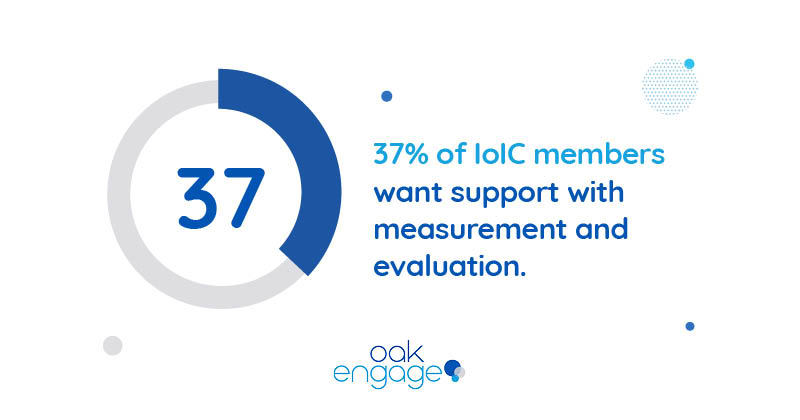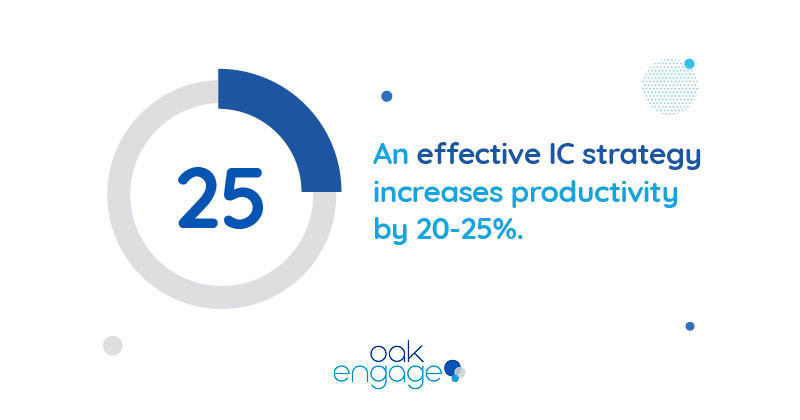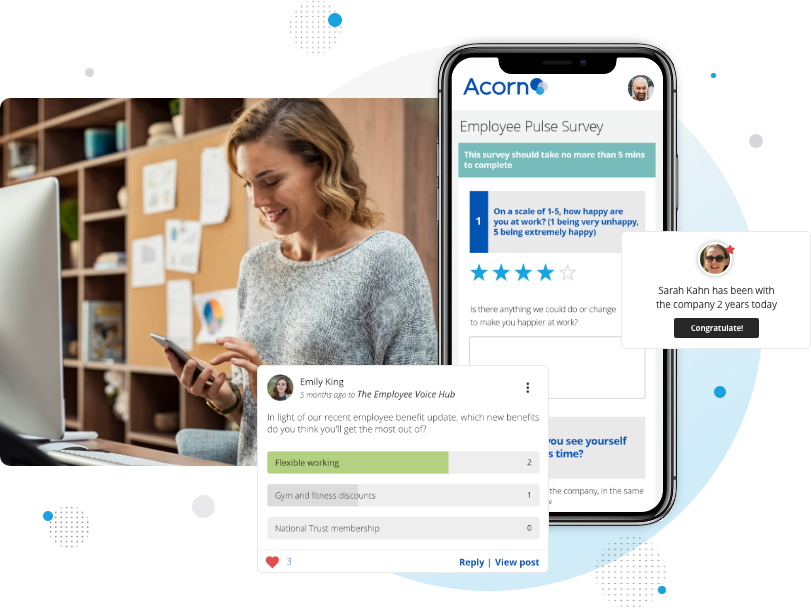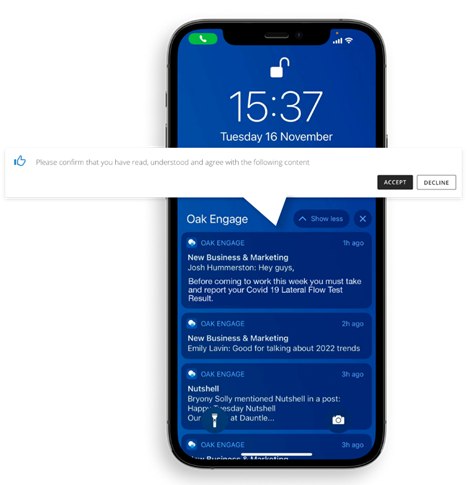The Value of Internal Communications Metrics
Internal communication metrics are imperative to understanding how to drive business growth and supercharge employee engagement. From giving you a more comprehensive understanding of what success looks like to providing your business with the means to make improvements, understand the impact of your communications, understanding the capacity for metrics in your business is vital:
- Evaluate communication strategies and identify areas for improvement.
- Foster employee engagement and boost productivity.
- Ensure alignment and consistency in messaging.
- Support effective change management.
- Drive continuous improvement in communication practices.
Without effective internal communications your workforce will be disengaged. Without an internal communications strategy driven by data, you won’t be able to have effective internal communications.
Sounds like a recipe for disaster doesn’t it?
IBM found that 72% of employees don’t have an understanding of their company’s strategy. And only 23% of executives say their companies align employees' goals with corporate purposes.
Communication is the glue that binds your business together. It enhances teamwork, collaboration and unites your people.

The rewards you reap as a business when you focus on internal communications are transformative - the reward being an engaged, productive and motivated workforce.
But, there is still a long way to go in achieving this.
It can be difficult to measure internal communications. Why? Because you’re measuring behaviour, productivity, engagement and attitudes. All very subjective things. But they're vital to measure as internal communications is an important and strategic function of your business.
The IoIC found that 37% of members said they want more support on measurement and evaluation when faced with the challenges of tracking internal communications.

After all, you can’t improve the things you can’t measure. In this blog post we’ll help set you on the right path to tracking your internal communications:
- Why Track Internal Communications?
- Challenges of Tracking Internal Comms
- Keeping On Top of Your Internal Comms
So What Are Internal Communications Metrics?
Internal communications metrics are any sort of data points that pay reference to specific engagement criteria in relation your content. This could be the specific engagement rates of your content, open rates within emails or even a general sentiment analysis. Here are a few examples:
- Email Open and Click-through Rates
- Intranet/Portal Usage
- Employee Survey Responses
- Communication Platform Metrics
- Town Hall/All-Hands Meeting Attendance
- Employee Feedback and Sentiment Analysis
- Social Intranet Engagement
- Knowledge Sharing Metrics
- Communication Channel Effectiveness
- Employee Adoption of New Processes/Tools
Metrics will differ for each and every business. Your internal communications KPIs are dependent on your objectives and what your business are hoping to achieve.
Why Track Internal Communications?
Tracking Internal Communications is key to your company's success.
McKinsey found that when companies have an existing and effective internal communication strategy, employees are 20 to 25% more productive. By tracking your comms you can begin to think about whether your messages, company values and goals are reaching your employees.

With many workers making the switch to remote work, your internal communications methods, tools and how you track them are more important now than ever before.
Good communications can make or break a company's success.
If you don’t track your internal communications you won’t be able to understand what motivates and connects your employees, how committed they are to company goals and strategy or the strength of your employer brand. So it’s important to get started as soon as possible.
Challenges of Tracking Internal Communications Metrics
Beginning to measure the success of your comms can feel overwhelming and many IC professionals feel that, despite the importance of tracking communications, that they don’t have the correct tools. The SCM (School for Communication and Management) found that almost half of IC professionals feel that they don’t have the correct tools to measure their comms.
As well as not having the correct resources to measure outcomes and strategies there are many other challenges that come with measuring communications:
- How do you define the internal communications metrics for successful communication? What are the channels and what are the outcomes?
- How do you combine the results from various communication channels?
- Can you measure the success of traditional methods like bulletin boards and email newsletters?
You need to assess your current strategy and make any changes so that you can begin to improve the way you communicate. Data is a powerful tool that can be used to our advantage and leveraging this data will show just how integral internal communications is for businesses.
How to Measure Internal Communications
It might be time for a spring clean of your internal communications channels. Looking at if they’re fit for your audience and learning how to measure them is the stepping stone to having a successful internal communications strategy. Follow these steps to begin measuring your internal communications:
Assess Your Current Comms Channels
What channels do you currently use for employee communication?
You’ll most likely be using a combination of operational and internal channels to connect with your workforce. These channels will have some crossover functions but you need to identify which channels you use and for what for purpose.
Operational channels are used by staff to perform their work duties, so things like:
- Instant Messaging Channels
- Asana
- Monday
Notion
Internal channels are ones used by your company to deliver messages and crucial information. This can include:
- An employee intranet
- Newsletters
- Employee App

Make a list of all the channels you use and write down the purpose that they serve.
Evaluate if They Are Fit for Purpose
Are the channels you’re using delivering your messages in the way that you want? You need to take a look at your channels and ask a number of questions:
Employee Reach
Does everyone in the workforce have access to these channels? Do deskless workers have the same access as those in the head office? The location shouldn’t be a barrier to communication. It’s important to make sure all your staff have the ability to connect and that your communications reach everyone in the business.
Two-Way Communication
Traditional leadership styles and one way communication are a thing of the past. Communication is about connecting and collaborating, so make sure you give your employees a voice and utilise tools that facilitate two-way communication like a social intranet. Things like surveys and polls can be used to gather feedback and improve collaboration.
Give your employees ways to engage with your messaging. Here are a few ways you can create more human centric communications:
- Suggestion boxes
- Idea walls
- Events
- Open meetings
- Recognition and celebrations
- Visual Content (Blogs & Video)
- Polls
- Hubs
- News

These methods encourage your employees to interact and connect with the business. Encouraging employee voice means employees will feel supported, passionate and happy within their role.
Could you use one channel rather than 5 to deliver your company messages? You might have an out of date intranet that doesn’t have the right functions and features you need to communicate with your people. If this is the case then why not switch to a modern intranet?
Measuring Your Internal Comms
Once you’ve assessed the channels you have in place and decided on what purpose they serve in your internal communications strategy you’ll have to measure the effectiveness of each channel. Your internal communications metrics will depend on it. Solely measuring the success of your internal communications through one metric won’t give you an accurate picture of how your whole strategy is working.
Use a range of metrics to reflect the channels you’re utilising and how your employees feel about them and the messages you’re sending. Using a combination of metrics gives you a holistic view of the success… or failures… of your internal communications strategy.
Employee Feedback
Again reiterating the importance of employee voice, if you want to know something from your employees, the fastest and easiest way to do that is to ask them!
Employee feedback is probably the most important internal communications metric because direct feedback is golden in understanding your employees and how they view your company.
Make use of engagement and pulse surveys, one-to-one meetings and stay interviews. All of these methods are brilliant for getting honest feedback from employees that you can use to find out what motivates and excites them, what they love about the company and what might need a bit of a reshuffle.

Employee Interactions
The best internal communications are two sided. The best content is content which causes interaction and enthusiasm. Make sure you can see how many employees are interacting with the content you put out, or if they’re just skimming past it. An employee interaction can be anything from clicking links to commenting and sharing posts.
It’s great to see if certain teams are interacting with your content, it might be the case that certain teams always engage with your content but others don’t. This might mean you need to tweak the messaging or switch up the medium of content for certain segments of your workforce. By measuring interactions, you’ll be able to find out what motivates and engages different employees and adjust accordingly.
Email - Open & Read Rates
Email open and read rates can be a good indicator of how your communications are performing. Strong open rates mean your subject lines are hitting the right spots and resonating with your employees, even better if your click rates are high too! It shows your content is interesting to your employees and gets their attention.
Whilst open and read rates can be useful metrics to assess as part of your overall strategy, analysing read receipts and page views on your company's intranet posts, blogs and messaging will give you a much better picture of whether your employees are engaging with your content and reading important updates.
Do you have a piece of news that your employees absolutely must read? Oak’s mandatory read feature pushes notifications to all employees that instruct them to read important news and content immediately.
Content Engagement & Page Visits
Users might well be logging into the app and checking it, but are they actually engaging with the content? Make sure you’re capturing page views and content engagement metrics for day-to-day optimization.
Track how often employees log into your intranet, how long they spend there, and whether they like and comment on content and participate in communities or hubs. As an IC professional, this will give you a firm idea of the level of effectiveness of an internal communication strategy and if you need to test out different methods.
A large chunk of corporate employees (87%) don’t feel that their employer “communicates effectively” with them.
We’ve got a great guide full of intranet content ideas to boost engagement from personalised content, employee recognition, Q&As and multimedia content. Be sure to give it a read!
Mobile App Downloads & Usage
Do you have an internal comms app for your company? If so, how many of your employees use it? If they do use it, how frequently is it - daily, weekly or monthly? By assessing the adoption rates of your digital app you’ll get an indication as to whether employees are actually engaging with your messaging and how well your communications are received overall.
If you have a low adoption rate you might need to switch up your strategy. If your employees aren’t using your internal comms app, ask them why and make any necessary adjustments.

Want to know the secret to getting high adoption rates? Our customer story explains how Five Guys were able to get 99% of their users accessing their mobile app through an Oak branded Intranet.
Benefit Sign Ups
If your company has a benefits programme, track to see how many employees are signed up to and how quickly they signed up. If most of them are then it’ll show that your communications are clear and encourage people to utilise the resources available to them. If enrolments are few and far between this can be a sure fire indicator that your current approach isn’t reaching people, or engaging them properly.
Employee Turnover Rates
Harvard Business Review demonstrates the direct relationship between turnover and engagement. Measuring retention rates gives you an overall snapshot of engagement levels in your company. Focusing on your turnover rates can also help you think more clearly about employee engagement and what might need to be changed within your communications strategy that can inspire and motivate staff.
Unsure on how you work out your turnover rate? We’ve got the formula right here:
- Staff turnover per month = (Total # of leavers per month / Average number of employees in a month) x 100
- Staff turnover per year = (Total number of leavers in a year / Average number of employees in a year) x 100
Create Your Benchmark
The secret to success with internal communications is measurements against a benchmark. Having a clear purpose and objective to work towards will make a huge difference in how you approach your internal communications strategy.
Create a benchmark to work towards or from, for how effective your channels should be. Are they any industry averages you should be focusing on? For some metrics, yes:
Employee Feedback: The industry standard for employee engagement surveys sits between 50-60% whilst anything between 60%-70% is a success. More than 70% and you know you’re doing something right.
Email - Open & Read Rates: Average open, read and click rates can vary between audiences. Not only that but they vary greatly by industry and company size. A company with 11 employees is much more likely to have employees engaging via email than a company with 1,100 employees.
MailChimp have a comprehensive and detailed breakdown of open and click rates by industry so take a look and see how your metrics compare. Once you’ve got an idea of where you’re performing, why not perform some A/B tests to see what types of communications resonate with your audience. Make sure you’re continuously reviewing campaigns so you can see what’s working and what might need adjusting.
Mobile App Downloads & Usage:
In 2020 people downloaded 218 billion apps. With communications like email becoming more outdated, people turn to their mobiles to access and digest important information. Having a company app can be transformative for your business - it connects your whole workforce, allows people to receive information instantly and engages your employees.
Employee Turnover Rates:
Employee turnover rates in the UK sit at around 15% whilst US turnover rates are around 20%. It’s important to consider that turnover rates vary greatly depending on the industry. Hospitality and retail are renowned for having some of the highest turnover rates.
When measuring employee turnover rates within your company or within teams it’s important to keep in mind a range of factors such as the industry you’re in, your previous turnover rates and promotion rates for an accurate view of how your company sits with regards to turnover.
Content Engagement, Page Visits and Employee Interactions:
Whilst there might not be an industry average for these internal communications metrics, the data provided from these metrics is usually face value. If your content engagement rates, page visits and general employee interaction is low, you might want to rethink your content medium. If you’re just speaking to your employees with long documents filled with text - why not create some fun video content or content that uses images to entice and engage people.

It’s been proven time and time again that video content is fast becoming the most popular content choice. But how does this relate to employee engagement? When manufacturing brand Stanley Black & Decker switched to a video-focused digital training program, it resulted in a 20% increase in employee engagement. Even our own customers Five Guys told us that video is key when forming part of your internal communications strategy.
Benefit Sign-Ups:
Are your employees aware of what their benefits are? Rather than having a folder of documents why not host a talk or event showcasing what their benefits give them and answer any questions they might have. This way they’ll be able to properly understand what's available and it will stick in their mind.
Assessing these metrics monthly and quarterly will help you form your own average that you can work against and help you to notice patterns on what performs well, and what isn’t so great for resonating with your audience.
Test & Improve
Consistency is one of the biggest factors to accomplishment and success.” – Byron Pulsifer
As with everything, consistency is key. Ensure that you’re continuously testing and analysing each and every channel you use so you can improve your internal communications efforts. The more you test and improve the more effective your channels will become and this will have a huge effect on the way you collaborate with your workforce.
By analysing patterns you can ensure that your comms really are engaging and inspiring your workforce. You’ll see what content performs well on specific channels and you’ll identify channels that don’t work so much. If certain channels aren’t doing so well, maybe have a rethink of those and place more of a focus on those that are and work to get the messaging right.
You’ll only know from consistent data, so make sure you have a set routine to analyse your data so you can always keep improving.
Benchmark Stats
Whilst it's important to set your own goals, objectives and benchmarks, it can be helpful to reference some generic data points to influence what you're aiming towards. Here are a few very generic examples.
-
Content Consumption: Employees usually spend about 10 to 20 minutes per session on the intranet, checking out news articles, company updates, policies, and other resources.
-
Popular Content: The sections that get the most attention on intranets are employee directories, company news, HR stuff like benefits info, and collaboration tools for shared documents and projects.
-
Mobile Access: More and more organizations are making their intranets mobile-friendly. Mobile access can make up roughly 30% to 50% of total intranet usage, as people like to stay connected on their phones.
-
Employee Contributions: Not everyone actively contributes, but there's usually a small percentage of employees, around 5% to 20%, who upload documents, comment, and join discussions on the intranet.
-
Search Queries: Employees like to search for information on the intranet, and they usually perform about 3 to 5 searches per session. It shows they're actively looking for what they need.
-
Feedback and Ratings: Some intranets allow employees to rate and give feedback on content. Positive ratings and feedback tell us that the content is relevant and helpful.
Keeping On Top of Your Internal Comms
Make sure you're consistently tracking these metrics so that you can adjust and improve your internal communications strategy regularly.
Follow these KPIs when assessing the value of your communications to your workforce and the nature of these messages and their effect on your various audiences, within and outside your company.
The quality of your corporate communications will have a huge influence on the way your workforce communicate, collaborate and work towards their goals. By following these strategies you’ll be able to keep on top of your internal communications game… because after all, in today's data driven world, you can’t afford not to!
In need of an internal communications template? We have a step by step guide here to get you started. Good luck!
Change the way you work. Empower your people
We offer a free and personalised demo service, showcasing our intuitive and easy to use platform.


![Internal Communications Metrics [For ICs & Managers]](/media/imopt2op/ic-metrics.png?width=50)
